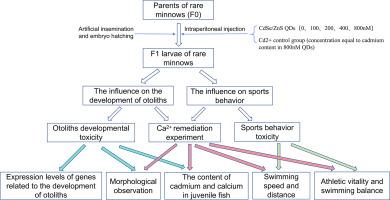父母暴露于CdSe/ZnS QDs会影响稀有鲦鱼后代的耳石发育和运动行为。
IF 4.3
3区 环境科学与生态学
Q2 BIOCHEMISTRY & MOLECULAR BIOLOGY
Comparative Biochemistry and Physiology C-toxicology & Pharmacology
Pub Date : 2025-09-20
DOI:10.1016/j.cbpc.2025.110360
引用次数: 0
摘要
量子点(QDs)影响耳石发育和运动行为,尽管潜在的机制尚不清楚。本研究以稀有鲦鱼(Gobiocypris rarus)为模型生物,评估了CdSe/ZnS量子点对下一代(F1)耳石发育和运动行为的毒性。将不同浓度的CdSe/ZnS QDs(0、100、200、400和800 nmol/L)处理4 d,人工授精收集胚胎。结果表明,不同浓度的QDs对F1幼虫的卵状和囊状耳石生长均有抑制作用,耳石外侧面积减小。此外,观察到畸形和死亡率的增加,以及游泳速度、移动距离和总体钙含量的降低,最终导致F1幼虫失去平衡控制。暴露于CdSe/ZnS QDs还抑制了atp2b1a、stm和sparc基因的转录表达,同时促进了cahz、ecac和omp1基因的转录。值得注意的是,CdSe/ZnS量子点对耳石生长和游泳行为的不利影响可以通过在环境中补充Ca2+来缓解。补钙后,幼体耳石发育损伤有所减轻,运动行为恢复正常。综上所述,CdSe/ZnS量子点可在个体和分子水平上对稀有鲦鱼F1幼虫的耳石发育和运动行为产生不利影响,最终导致游泳能力和平衡控制能力受损。本文章由计算机程序翻译,如有差异,请以英文原文为准。

Parental exposure to CdSe/ZnS QDs affects otolith development and locomotor behavior in rare minnow (Gobiocypris rarus) offspring
Quantum dots (QDs) influence otolith development and locomotor behavior, although the underlying mechanism remain unclear. This study evaluated the toxicity of CdSe/ZnS QDs on otolith development and locomotor behavior in the next generation (F1) using rare minnows (Gobiocypris rarus) as model organisms. The sexually mature parents of rare minnows (F0) were exposed to varying concentrations of CdSe/ZnS QDs (0, 100, 200, 400 and 800 nmol/L) for four days, after which embryos were collected through artificial insemination. The results indicated that exposure to varying concentrations of QDs inhibited the growth of utricular and saccular otoliths in F1 larvae, evidenced by a decrease in otolith lateral area. Furthermore, an increase in malformations and mortality rate were observed, alongside reductions in swimming speed, movement distance and overall calcium content, ultimately resulting in loss of balance control in F1 larvae. Exposure to CdSe/ZnS QDs also suppressed the transcript expression of the atp2b1a, stm and sparc genes, while promoting the transcription of cahz, ecac and omp1 genes. Notably, the adverse effects of CdSe/ZnS QDs on otolith growth and swimming behavior could be mitigated by supplementing Ca2+ in the environment. Following calcium supplementation, the damage to otolith development in larvae was alleviated to some extent, and locomotor behavior returned to normal. Overall, the results suggest that CdSe/ZnS QDs can adversely affect otolith development and locomotor behavior in F1 larvae of rare minnows at both individual and molecular levels, ultimately leading to impaired swimming abilities and balance control.
求助全文
通过发布文献求助,成功后即可免费获取论文全文。
去求助
来源期刊
CiteScore
7.50
自引率
5.10%
发文量
206
审稿时长
30 days
期刊介绍:
Part C: Toxicology and Pharmacology. This journal is concerned with chemical and drug action at different levels of organization, biotransformation of xenobiotics, mechanisms of toxicity, including reactive oxygen species and carcinogenesis, endocrine disruptors, natural products chemistry, and signal transduction with a molecular approach to these fields.

 求助内容:
求助内容: 应助结果提醒方式:
应助结果提醒方式:


